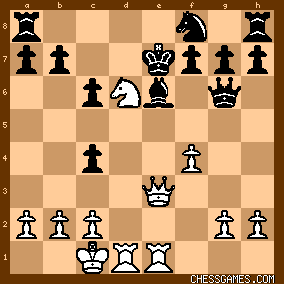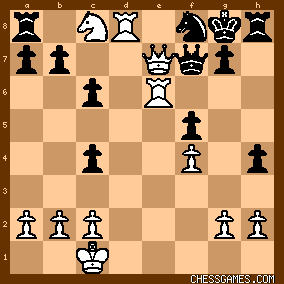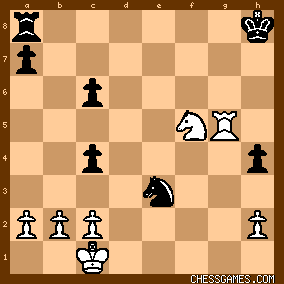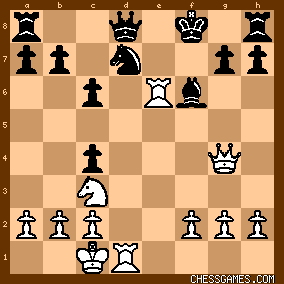| Nov-27-06 | | Erdem Yildiz: What a good game in 1904. |
|
Nov-27-06
 | | WannaBe: I honestly can say, I don't get the pun. =( |
|
| Nov-27-06 | | Infohunter: <WannaBe: I honestly can say, I don't get the pun. =(>
It's a take-off on the French expression _embarrasse des riches_, which means "embarrassment of riches." Normally that means that one has so many things going for him that he hardly knows where to begin. Here, of course, cg.com is spoofing Black's first name. The game ends with his being "embarrassed" for a decent move. |
|
| Nov-27-06 | | think: This was a very exciting game. Its comical that white can keep his bishop on c4 for most of the game. It is a good exercise to figure out how white punishes dxc4 on various moves. After 11. ... dxc4 12. Nxe6 fxe6 13. Rxe6 black has an amazing 3 pins to deal with.
Why not 16. ... dxc4? |
|
| Nov-27-06 | | Confuse: Can someone post the analysis for the finish? Thanks in advance |
|
| Nov-27-06 | | nescio: <Confuse: Can someone post the analysis for the finish? Thanks in advance> White threatens 31.Nxe6 fxe6 32.Rxe6 or even 32.Re5 and the black position collapses. There is very little Black can do about it, for example 30...Rd8 31.Qc7 Rc8 32.Qb7 Qg5 33.Kb1. I remember only the expression "embarras du choix" which I would translate as "difficult choice". |
|
| Nov-27-06 | | makaveli52: <think> Ne4 followed by Nd6+ looks pretty lethal |
|
| Nov-27-06 | | crafty: 30. ... ♖d8 31. ♕c7 ♖c8 32. ♕b7 ♔f8 33. ♘xe6+  (eval 2.09; depth 14 ply; 1000M nodes) (eval 2.09; depth 14 ply; 1000M nodes) |
|
Nov-27-06
 | | Honza Cervenka: <think><Why not 16. ... dxc4?> 16...dxc4 17.Ne4 Qg6 18.Nd6+ Ke7 19.f4 (see diagram) looks pretty bad for black.
click for larger viewFor example 19...f5 fails for 20.g4! fxg4 21.Kb1! and the threat 22.f5  is unavoidable. Maybe 19...h5 can prolong the fight as after 20.f5 black has 20...Qh6 with exchange of Queens and 20.Kb1 allows 20...f5. But for example after 20.Qa3!? f5 21.Re3! with idea 21...Kf6? 22.Qc3+ Ke7 23.Rg3 is unavoidable. Maybe 19...h5 can prolong the fight as after 20.f5 black has 20...Qh6 with exchange of Queens and 20.Kb1 allows 20...f5. But for example after 20.Qa3!? f5 21.Re3! with idea 21...Kf6? 22.Qc3+ Ke7 23.Rg3  I don't see how black can consolidate his position. The best can be 21...h4 22.Nc8++ Kf7 23.Qe7+ Kg8 24.Rd8 Qf7 25.Rxe6 (see diagram) but it seems to lead to an better ending of white. I don't see how black can consolidate his position. The best can be 21...h4 22.Nc8++ Kf7 23.Qe7+ Kg8 24.Rd8 Qf7 25.Rxe6 (see diagram) but it seems to lead to an better ending of white. 
click for larger viewA possible continuation can be 25...Qxe7 26.Rxe7 Kh7 27.Rxb7 Ne6 28.Rxh8+ Kxh8 29.Nd6 Nxf4 30.Nxf5 Nxg2 31.Rxg7 Ne3 32.Rg5 (see diagram) which looks quite hopeless for black. 
click for larger view |
|
Nov-27-06
 | | Honza Cervenka: <After 11. ... dxc4 12. Nxe6 fxe6 13. Rxe6 black has an amazing 3 pins to deal with.> That's true but still 13...0-0 can be playable here. After 14.Qxc4 Kh8 15.Ne4!? Qa5! black keeps material as 16.Rxe7 Nxe4 17.Qxe4 Qxg5 or 16.Bd2 Qd5 only trades material. Only white's chance to prolong the attack seems to be 16.Rxe7 Nxe4 17.Bh6!? (17.Rxg7 Ndf6! solves black troubles immediately) 17...gxh6 18.Rdxd7 but I don't think that white has enough to keep the game. I think that after 11...dxc4 12.Nxe6 fxe6 white would continue rather 13.Bxf6 Bxf6 (13...gxf6 gives draw at least to white and he can still try to achieve more) 14.Rxe6 Kf8 15.Qg4! (see diagram) threatening 16.Rxd7! Qxd7 17.Rxf6+ with strong initiative. 
click for larger view |
|
Nov-27-06
 | | Honza Cervenka: More forcible finish would have been 30.Nxe6 fxe6 31.Rxe6 Qg5+ (the only way to cover Ne7) 32.Kb1 Kf7 (32...Rd8 33.Qxc6+  ) 33.Rf1+ Kg8 34.Rxe7 ) 33.Rf1+ Kg8 34.Rxe7  29...Nf8 would have been better. After that 30.Rde1 Qg5 31.Nxe6 fxe6 32.h4 Qf5 33.Re5 Qf3 34.R5e3 Qf2! 35.Rxe6+ Kf7 (Of course, 35...Nxe6?? 36.Qxe6+ leads to quick mate.) 36.Re7+ Kg8 37.Rxg7+ Kxg7 38.Re7+ Kg8 39.Qe5 Qg1+ 40.Kd2 Qf2+ with perpetual as white King cannot go to the third rank for Qf3+ with next Qg4 eliminating white's mating threats. |
|
Nov-27-06
 | | WannaBe: <Infohunter> Thank you. |
|
| Nov-27-06 | | kevin86: Despite being a piece down,white's attack is very brutal-with the battering rams coming up the e-file right to the king. There is no escape-save castling,which is of course,illegal-since black has already done it! |
|
| Nov-27-06 | | beenthere240: what about 20...Kc8, threatening the draw by repetition? |
|
| Nov-27-06 | | Albertan: Schlechter's 16th move was a mistake.Instead he should have played 16.Qxf6 and play might have continued: 16.Qxf6 gxf6 17. Bd3 O-O-O 18. Ne2 Ng6 19.Nd4 Rhe8 20. Bf5 Bxf5 21. Nxf5 Re5 22. g4 Kd7  Hiarcs 10 suggested that on move 22 a pawn sacrifice was possible for Teichmann: 22...b6!? and play might have continued: 23.Qxb6 Nd7 24.Nxd7 Kxd7 25.Qa7+ Kd6 26.Rc3 Qf4+ 27.Rd2 Rc8 28.g3 Qb4 29.a3 Qb8 30.Qd4 f6  Hiarcs 10 evaluated that a better idea for Schlechter on move 25 was to play 25.Qd6 and play might have continued 25...c5 26.Kb1 Qxd6 27.Nxd6+ Kd7 28.Nxc8 Rxc8  Teichmann's big mistake in this game was on move 29 with 29...Ne7? Instead he should have played 29...Nf8 and play might have continued 30.Rde1 Qg5 31.Nxe6 fxe6 32.h4 Qf5 and had equality. An even stronger idea for Schlechter on move 30 was to play 30.Nxe6 with this continuation possible: 30.Nxe6 fxe6 31. Rxe6 Qg5+ 32. Kb1 Kf7 33. Rf1+ Kg8 34. h4 Nf5 35. Qe5 Qd8 36.
Rxf5 h6 37. Re7 Qxe7 38. Qxe7  |
|
| Nov-27-06 | | Dobbs: what a game! |
|
| Nov-27-06 | | drzebra: I'm not following the resignation.
Black may not have a pretty situation but can't he draw after 30...Qg5? |
|
| Nov-27-06 | | themindset: 13...Ne6 is the refutation of white's play, and leads to an endgame with advantage for black. |
|
| Nov-28-06 | | Infohunter: <drzebra: I'm not following the resignation.
Black may not have a pretty situation but can't he draw after 30...Qg5?> 30...Qg5 31.h4 Qf6 32.Nd7 Bxd7 33.Rxe7+! |
|
| Nov-16-15 | | transpose: I agree with <think>, that it is a useful exercise to go through the game figuring out what white would do if black had captured the c4 bishop every opportunity it arose. A modern computer would have indeed defended better and not lost the game, but Schlechter's treatment is beautiful to behold and no doubt frustrating for his (or any) human opponent. |
|





